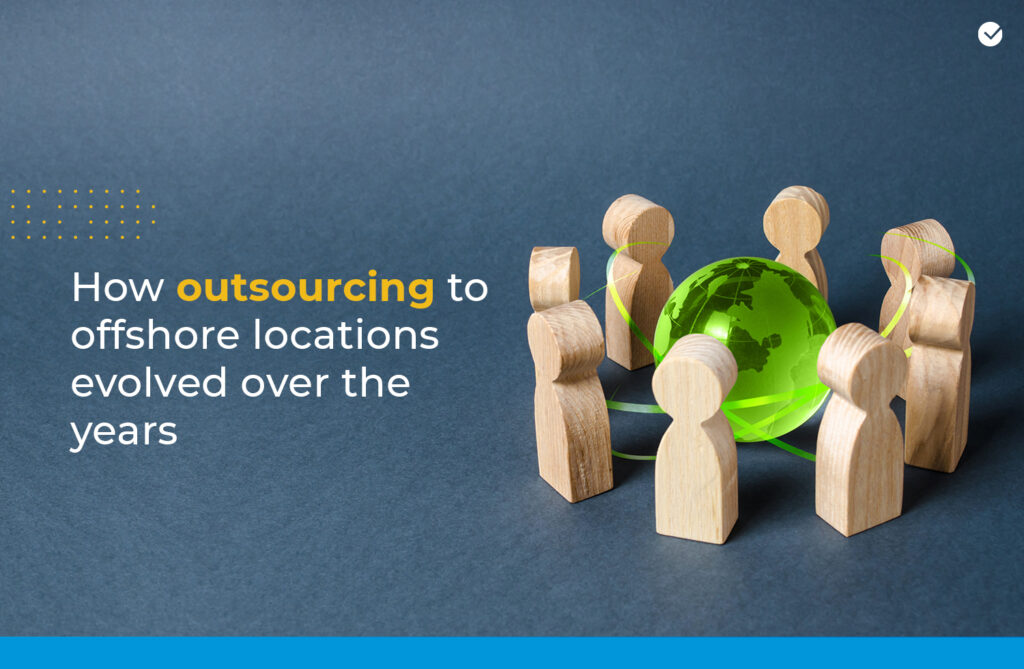Over the last few decades, we have seen several (and some more significant than others) changes to the way companies outsource to offshore locations. One of the key differences that stand out is the widely available talent pool for outsourcing, no matter the geographical pin, opening doors to corporates and widening profit margins. Furthermore, COVID-19 has forced many companies to adapt to a remote-first landscape, probably faster than anticipated.
Outsourcing offshore has become easier than ever with the advancement of technology that enables teams to communicate more efficiently, regardless of where they are in the world.
In the past half-century, outsourcing offshore has undergone substantial changes, and so too has its objective, influencing its evolution. Therefore, we will analyze how its perceived purpose extends to businesses to understand its advancement in depth.
Adding value to the offering
As mentioned above, up until recently, the primary purpose of outsourcing offshore was mostly to reduce labor costs. Businesses of wealthier countries have been outsourcing their operations overseas to increase their bottom line, allowing countries like Brazil, Russia, India, and China to flourish.
With the advancement of technology and streamlining the outsourcing process, in many cases, outsourcing has shifted from cost saving to increasing expertise and talent expansion. For example, China and India are known for offering high-skilled tech sector talent pools. Therefore, by outsourcing certain aspects to these countries, substantial value could be added that could help gain a competitive advantage and enable companies to expand in new markets.
Thirty years ago, many companies would have outsourced abroad in high volumes to make savings on costs. Thanks to PEOs, employers can now select the number of employees they want to work with at a specific location. This allows companies to become more customer-focused without setting up an entity.
Process improvements
A few decades ago, offshoring was not necessarily done to innovate business processes. Fast forward to today, outsourcing to offshore locations is leveraged to improve business processes and boost productivity. Due to advancing technology in greater automation and personalization, businesses can save time and improve their operations by outsourcing to those who can utilize these technologies effectively. This frees up more time for the company to focus on its core business strategies.
Enhance workforce capabilities
Just as the culture is different in many countries, so are the workforce’s capabilities. With communication and platforms quickly facilitating the outsourcing to offshore locations, this has now become a key reason for those wanting to do so. For example, suppose you want to design a reasonably priced app. In that case, you could easily outsource the task to a company or individual from an offshore location, capable of doing it quickly, cost-effectively, and of a high standard.
As technology enables more effective communication between companies and their offshore partners, utilizing improved capabilities for a business service offering can now be accomplished more efficiently than ever.
Strategic benefit
Offshoring makes things easier and faster, but it also offers a number of strategic advantages, especially when it comes to start-up businesses, which can save on costs and enter new markets quicker.
In the 1980s, offshore outsourcing often meant an all-or-nothing approach. Today, offshore outsourcing can be accomplished much quicker, thanks to advanced communication and software structures. It provides strategic benefits to organizations of entering new markets quickly and responding to surges in demand with fewer resources and being more agile, adapting to market fluctuations.
With fewer predetermined contracts and more custom outsourcing agreements, pricing and scope of work can be more flexible, helping to improve collaboration outcomes.
From blue-collar to white-collar
Two prominent researchers from the University of California believe there are two stages in the outsourcing model. The first stage involved the outsourcing of “blue-collar jobs.” According to Bardhan and Kroll, “One of the modern stages of globalization attributes for advanced industrialized countries is the offshore production of intermediate inputs, usually in cost-effective developing countries.” The motivation for the organizations was the availability of a skilled workforce, a business-friendly environment, and workers who can be found for a relatively low price. According to the Economist, by the 1980s, the offshore outsourcing practice was well and truly established.
As stated by Bardon and Kroll, the second part of outsourcing is when companies started outsourcing “white-collar jobs.” The early 2000s can be seen when offshore outsourcing took off in America. A significant shift in outsourcing services in the tech, IT, and software sectors was noticed during this period. According to a report, this shift in outsourcing was facilitated due to “widely disseminated technological advancements that permit low cost, good quality, and high-speed transmission of voice and data communications.”
In the future
As offshore outsourcing is becoming increasingly popular for businesses and economies alike, it seems that its future is bright. The process continues to innovate, and judging by the last few years, it appears that outsourcing core business tasks will enable organizations to streamline operations and reach new heights. Leveraging technology and automation will further enhance communication between partners and ultimately lead to a more effective process.
Contributed by Procorre
References
Bardhan, A and Kroll, C. (2003). The New Wave of Outsourcing. Fisher Centre Research Reports. 1 (1), 2.
Brainard, L and Collins, S. (2005). Offshoring White-Collar Work: Editors’ Summary. Booking Trade Forum. 1 (summary), 1.
Levine, L. (2011). Offshoring (or Offshore Outsourcing) and Job Loss Among US Workers. Congressional Research Services. 1 (summary), 1.
Videira, M. (2009). The Evolution of Outsourcing. Honors Program at the University of Rhode Island. 1 (1), 6.









